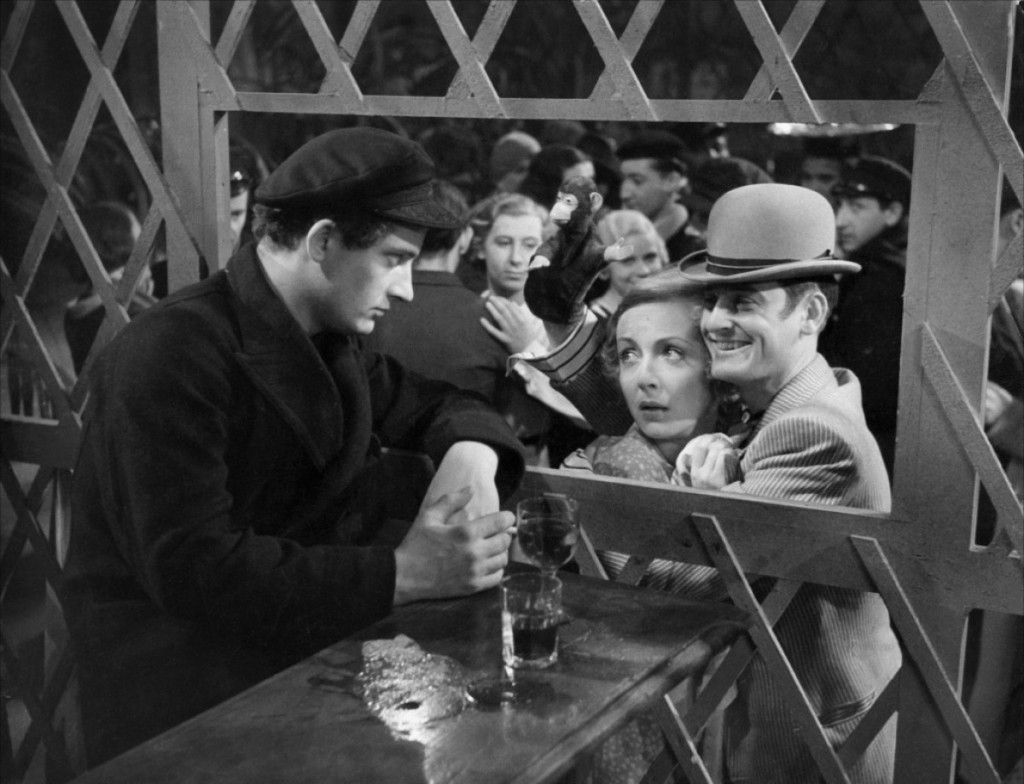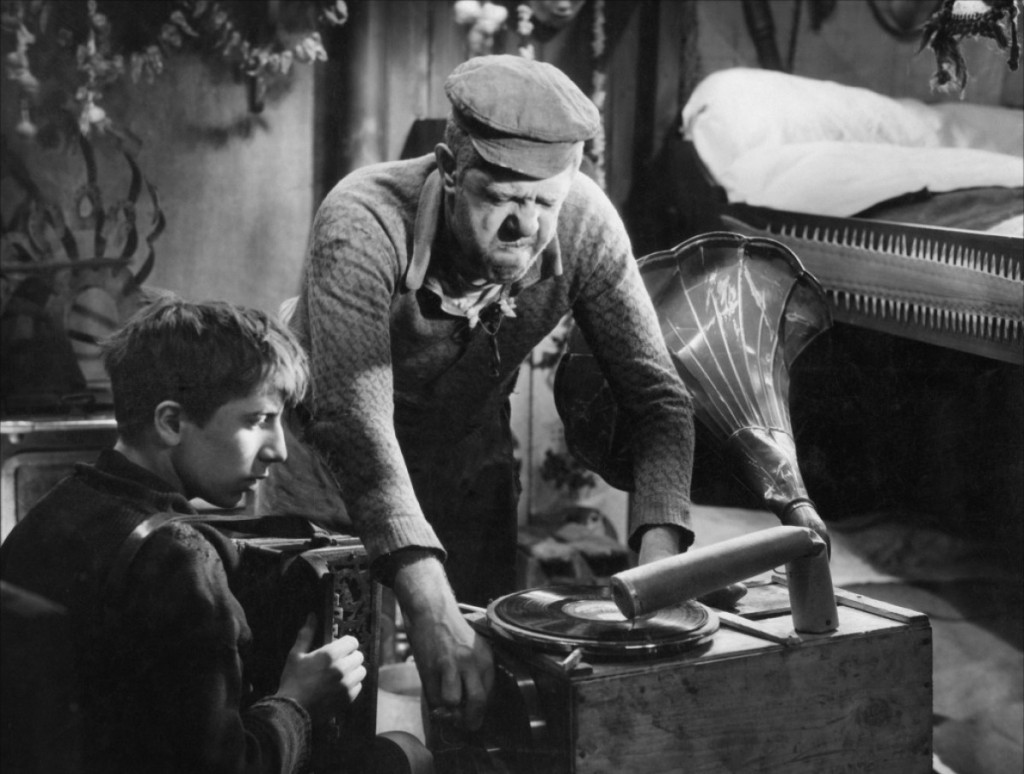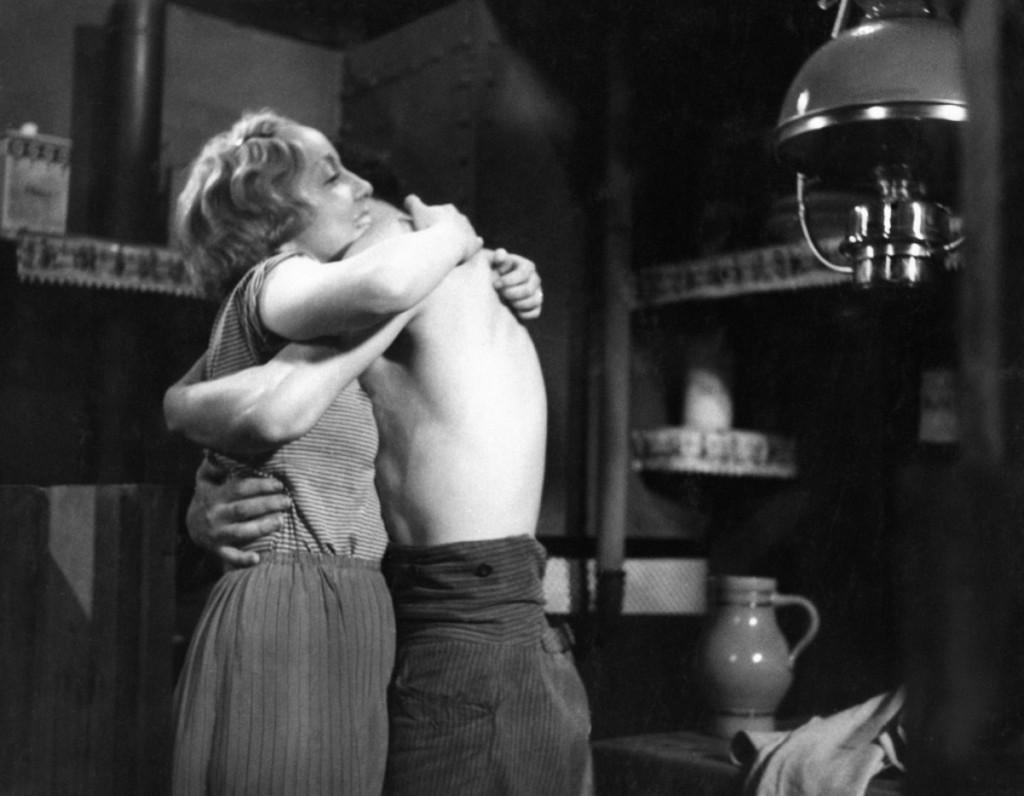L’Atalante is a movie of an unfocused and diffuse eroticism. The sexual energy officially arises from newlyweds Dita Parlo and Jean Dasté, but is in no way contained by them. The lust we breathe in every frame of L’Atalante is not entirely about feelings between people, and perhaps only partially, dimly about that; when trying to summon the experience of Jean Vigo’s only feature, a complete account must locate and acknowledge a similar feeling between people and animals, people and things, things and things. The ‘between’ might even be more important than the subjects it joins; this is a movie about air, both the heavy mist that greets the bargemates as night stumbles into morning and, more fancifully, the shared space that these creatures inhabit, that is created out of their union. In one of the most celebrated sequences, this is literally true: Parlo and Dasté simultaneously will into existence an imaginary, common plane when sleeping in separate beds miles apart. As they fondle themselves singly, aloneness falls away at the feet of an unnamed kingdom.
Where are we in L’Atalante? Shot on location and in studio, the footage from each is seamlessly blended together in a movie where the seams are otherwise ever present. (Even on repeat viewing, no cut ever falls quite where we anticipate—the camera veers off somewhere when expected grammar dictates a cut and the rhythm is eternally, infernally loopy.) It’s a movie that proceeds from a dream of a romantic, impossibly sophisticated Paris and rudely reminds us of pickpockets, hunger, cold, and confusion in the selfsame city—and yet the deprivations of the latter in no way impugn, or even interrupt, the validity of the former. It’s a movie that respects the fantasies of young hicks for whom the enticements of a garbled radio signal are genuine refinements. It takes great pleasure in realizing that sphere. And yet the bowels of the eponymous ship are unquestionably denser than the world outside, littered with objects that grow more mysterious as they’re explained. It’s the inverse of Noah’s Ark—Michel Simon has been charged with preserving the rude treasures of civilization while the species itself is left to drown. His collection is also, what with its alternative and artifactual sense of history, a clear ancestor of the Museum of Jurassic Technology. (The profusion of cats also suggests a parallel to Julian’s old screening room and I suspect those with little tolerance for kittens tumbling out of every crevice and corner will have even less patience for L’Atalante.)
 In a basic sense, L’Atalante is both poetically and materially elusive. The two qualities are related and, indeed, have fed off one another. It always feel like it’s on the verge of disappearance.
In a basic sense, L’Atalante is both poetically and materially elusive. The two qualities are related and, indeed, have fed off one another. It always feel like it’s on the verge of disappearance.
Famously, Vigo’s producer (a sympathetic financier, one who set up the project even after the total loss incurred by Vigo’s essentially unexhibitable Zéro de Conduite) cracked under pressure from provincial showmen and Gaumont brass and allowed the re-cutting of L’Atalante. Already an ostensibly commercial package, no amount of fiddling could pass off L’Atalante as something conventionally whole. The version originally seen in Paris in 1934—re-named Le chaland qui passe after a song shoe-horned into the movie alongside Maurice Jaubert’s terrific and brittle score—survives, more or less, but has not been shown for decades. Successive restorations following Vigo’s death supplanted one another. Did we remember a sequence in an older version or create it out of whole cloth? Accounts of outtakes and excised scenes in P.E. Salles Gomes’s biography blended with memories of prints projected on screen.
Mention should be made that the reputation of L’Atalante probably out-stripped its visibility in any version for much of the film’s life. When it finally made its way to America in 1947, it played a double bill with Zéro at the Fifth Avenue Playhouse in New York. L’Atalante seemingly never received a theatrical run in Chicago. The Documentary Film Group, the student film society at the University of Chicago, advertised the Chicago premiere in 1949—and again in 1952, the earlier engagement probably canceled and replaced at the last minute or simply forgotten outright. In any case, circulation on crappy 16mm prints was the rule for the next several decades.
 In the late 1980s, Gaumont received access to a pristine British copy, a previously unknown pre-release cut. It still wasn’t ‘complete,’ whatever that means, and certain scenes were obviously supplemented with footage from an inferior source in the restoration that debuted in 1990. This restoration, nine minutes longer than any previous version, even incorporated bits that Vigo himself had never finished or found room for in the fine cut, notably a lovely shot of Dasté caressing a block of ice and Simon wrestling with himself in double exposure. The whole thing was described by Terrence Rafferty, in the most insightful treatment that L’Atalante has yet received, as “still messy, imperfect, defiantly incomplete,” the added material “just extra stuff, beautiful and inessential and thus fully in keeping with the movie’s expansive spirit.”
In the late 1980s, Gaumont received access to a pristine British copy, a previously unknown pre-release cut. It still wasn’t ‘complete,’ whatever that means, and certain scenes were obviously supplemented with footage from an inferior source in the restoration that debuted in 1990. This restoration, nine minutes longer than any previous version, even incorporated bits that Vigo himself had never finished or found room for in the fine cut, notably a lovely shot of Dasté caressing a block of ice and Simon wrestling with himself in double exposure. The whole thing was described by Terrence Rafferty, in the most insightful treatment that L’Atalante has yet received, as “still messy, imperfect, defiantly incomplete,” the added material “just extra stuff, beautiful and inessential and thus fully in keeping with the movie’s expansive spirit.”
Ironically, Gaumont revised the restoration for video release in 2001 and deleted some of the shots that had been re-integrated in 1990, including the two cited above. The VHS tape included things that were excluded from the subsequent DVD; who knows what’s in store for the Blu-ray that Criterion will release next month? Video is the ideal vehicle for these ever-changing scholarly dispositions, with each new iteration conveniently lacking the traces of its predecessors. (Without disputing the methodology that justified this revision, those of us who love L’Atalante feel a giddy, illict right to every frame of it.)
Celluloid is a trickier thing because new edits entail recalling prints and recutting negatives. L’Atalante has been unavailable for theatrical screenings for the past several years, seemingly lost in the lurch while American licensor New Yorker Films dealt with bankruptcy and reorganization. The print that we’ll be screening on Wednesday, by virtue of its convoluted chain of ownership, still includes the shots that Gaumont un-restored in 2001. It’s a testament to the durability of film and the fragility of L’Atalante.
The Northwest Chicago Film Society will screen a 35mm print of L’Atalante from the University of Chicago Film Studies Center on Wednesday, July 20 at the Portage Theater at 7:30. Special thanks to Julia Gibbs and Brian Belovarac. Please see our current calendar for more information.


